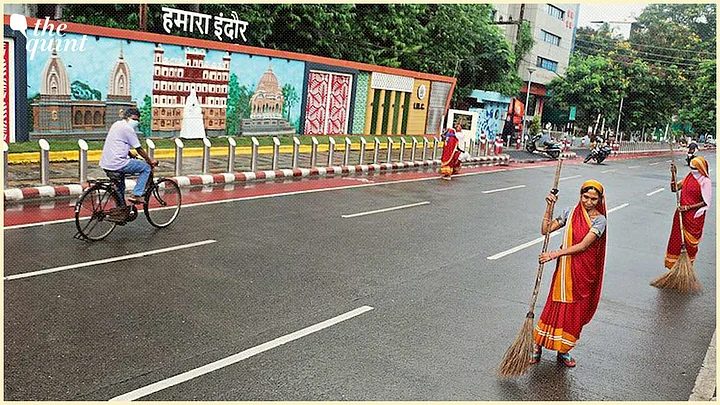Indore in Madhya Pradesh has been adjuged as India’s cleanest city for the sixth time in a row.
The results of the Union government's Swachh Survekshan survery was announced on Saturday, 1 October. From occupying the 25th rank in the cleanliness survey in 2016 to having topped the national civic ranking as the cleanest city in India for the last six consecutive years, the city's turnaround story is noteworthy.
Indore is also India’s first seven-star garbage-free city, which is one of the key objectives of the second iteration of the Swachh Bharat Mission launched last year. Here is how the city manages its waste, and, in the process, also generating a revenue:
Explained | How India's Cleanest City Indore Earns Big Bucks From Its Garbage
1. Amount of Waste Generated
With an estimated population of about 35 lakh, the commercial capital of Madhya Pradesh produces 1,900 tons of garbage everyday. The city generates 1,200 tons of dry waste and 700 tons of wet waste daily. What started off as a pilot exercise in two wards has turned into a full-fledged exercise. In 2015, the coropporation started door-to-door waste collection wards on a pilot basis in two wards. Encouraged by the response, they decided to adopt it full-time. By the end of 2016, the IMC was carrying out 100 percent door-to-door collection of garbage.
Expand2. Waste Segregation
Where most places in India segegate their garbage into two categories (the wet and dry waste), the waste in Indore is segretaged into six categories at a collection point.
Mahesh Sharma, cleanliness wing superintendent engineer of the Indore Municipal Corporation (IMC), told Outlook that the corporation has 850 vehicles which collect waste from households and business establishments and segregate it into six categories. The six categories are: wet, electronics, plastics, non-plastic, biomedical, and hazardous. Further, the vehicles have separate compartments for different types of waste. For example, discarded sanitary napkins go into a separate waste compartment.Expand3. Round The Clock Work by Safai Mitras
It takes about 8,500 safai mitras (sanitary workers) to keep the city clean. These workers work in three shifts, added Sharma.
Expand4. Asia's Largest Bio-CNG Plant
The highlight of the the civic body's waste disposal process is a bio-CNG plant which runs on the wet waste collected from across the city. It is Asia's largest such facility, according to city officials.
On 19 February this year, Prime Minister Narendra Modi inaugurated the 550 MT per day capacity plant worth Rs 150 crore at the Devguradia trenching ground. It can generate 17,000 to 18,000 kg of bio-CNG and 10 tonnes of organic manure.
About 150 city buses are being run on this Bio-CNG which is Rs 5 cheaper than commercial CNG. The civic body earned Rs 14.45 crore from waste disposal last fiscal, including Rs 8.5 crore from the sale of carbon credits in the international market and Rs 2.52 crore as annual premium from a private company for providing waste to the bio-CNG plant.
In the current fiscal, the civic body hopes to earn Rs 20 crore from waste disposal, said Sharma.
Sewage generated in Indore too is treated at three special plants and reused at 200 public gardens, farms, and for construction activities.
(At The Quint, we question everything. Play an active role in shaping our journalism by becoming a member today.)
Expand
Amount of Waste Generated
With an estimated population of about 35 lakh, the commercial capital of Madhya Pradesh produces 1,900 tons of garbage everyday. The city generates 1,200 tons of dry waste and 700 tons of wet waste daily. What started off as a pilot exercise in two wards has turned into a full-fledged exercise. In 2015, the coropporation started door-to-door waste collection wards on a pilot basis in two wards. Encouraged by the response, they decided to adopt it full-time. By the end of 2016, the IMC was carrying out 100 percent door-to-door collection of garbage.
Waste Segregation
Where most places in India segegate their garbage into two categories (the wet and dry waste), the waste in Indore is segretaged into six categories at a collection point.
Mahesh Sharma, cleanliness wing superintendent engineer of the Indore Municipal Corporation (IMC), told Outlook that the corporation has 850 vehicles which collect waste from households and business establishments and segregate it into six categories. The six categories are: wet, electronics, plastics, non-plastic, biomedical, and hazardous. Further, the vehicles have separate compartments for different types of waste. For example, discarded sanitary napkins go into a separate waste compartment.
Round The Clock Work by Safai Mitras
It takes about 8,500 safai mitras (sanitary workers) to keep the city clean. These workers work in three shifts, added Sharma.
Asia's Largest Bio-CNG Plant
The highlight of the the civic body's waste disposal process is a bio-CNG plant which runs on the wet waste collected from across the city. It is Asia's largest such facility, according to city officials.
On 19 February this year, Prime Minister Narendra Modi inaugurated the 550 MT per day capacity plant worth Rs 150 crore at the Devguradia trenching ground. It can generate 17,000 to 18,000 kg of bio-CNG and 10 tonnes of organic manure.
About 150 city buses are being run on this Bio-CNG which is Rs 5 cheaper than commercial CNG. The civic body earned Rs 14.45 crore from waste disposal last fiscal, including Rs 8.5 crore from the sale of carbon credits in the international market and Rs 2.52 crore as annual premium from a private company for providing waste to the bio-CNG plant.
In the current fiscal, the civic body hopes to earn Rs 20 crore from waste disposal, said Sharma.
Sewage generated in Indore too is treated at three special plants and reused at 200 public gardens, farms, and for construction activities.
(At The Quint, we question everything. Play an active role in shaping our journalism by becoming a member today.)
